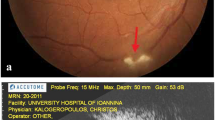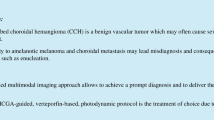Abstract
Purpose To evaluate the efficacy and safety of photodynamic therapy (PDT) in the long-term control of subfoveal choroidal neovascularization (CNV) associated with toxoplasmic retinochoroiditis. Methods The records of 13 patients with classic subfoveal CNV associated with toxoplasmic retinochoroiditis treated with PDT were reviewed. All patients were followed up for at least 48 months. Postoperative visual acuity was defined as a gain or loss of two or more lines of best-corrected visual acuity (BCVA), respectively. Post-treatment CNV size was dichotomized into “increased” if the major CNV diameter (CMD) had increased by ≥300 μm, and as “stable/reduced” if it had decreased by ≥300 μm or had not changed by >300 μm. Results Nine patients [four males (44.4%) and five females (55.6%)] with a mean age of 20.1 ± 4.3 years (range 14–27 years) were enrolled in the study. All had unilateral involvement. The median follow-up was 55 months (minimum 48, maximum 65 months). At the 48-month follow-up, all patients had stable/improved BCVA and a mean stable/reduced CMD (846 ± 326.5 μm), with the BCVA having improved significantly (p < 0.0001) from 0.29 ± 0.19 at baseline to 0.54 ± 0.16 at 48 months. Conclusion Photodynamic therapy seems to be a safe and effective approach to the long-term control of subfoveal CNV associated with toxoplasmic retinochoroiditis. Further trials are needed to validate these findings.




Similar content being viewed by others
References
Schlaegel TF Jr, Weber JC (1984) The macula in ocular toxoplasmosis. Arch Ophthalmol 102:697–698
Skorska I, Soubrane G, Coscas G (1984) Toxoplasmic choroiditis and subretinal new vessels. J Fr Ophtalmol 7:211–218
Atmaca LS, Simsek T, Batioglu F (2004) Clinical features and prognosis in ocular toxoplasmosis. Jpn J Ophthalmol 48:386–391. doi:10.1007/s10384-003-0069-0
Bressler NM, Treatment of Age-Related Macular Degeneration with Photodynamic Therapy (TAP) Study Group (2001) Photodynamic therapy of subfoveal choroidal neovascularization in age-related macular degeneration with verteporfin: two-year results of 2 randomized clinical trials—TAP report 2. Arch Ophthalmol 119:198–207
Mauget-Faysse M, Mimoun G, Ruiz-Moreno JM, Quaranta-El Maftouhi M, De Laey JJ, Postelmans L, Soubrane G, Defauchy M, Leys A (2006) Verteporfin photodynamic therapy for choroidal neovascularization associated with toxoplasmic retinochoroiditis. Retina 26:396–403. doi:10.1097/00006982-200604000-00003
Verteporfin in Photodynamic Therapy Study Group (2001) Verteporfin therapy of subfoveal choroidal neovascularization in age-related macular degeneration: two-year results of a randomized clinical trial including lesions with occult with no classic choroidal neovascularization—verteporfin in photodynamic therapy report 2. Am J Ophthalmol 131:541–560. doi:10.1016/S0002-9394(01)00967-9
Verteporfin in Photodynamic Therapy Study Group (2001) Photodynamic therapy of subfoveal choroidal neovascularization in pathologic myopia with verteporfin. One-year results of a randomized clinical trial—VIP report no. 1. Ophthalmology 108:841–852. doi:10.1016/S0161-6420(01)00544-9
Aaberg TM, VOH Study Group (2004) Four-year results of verteporfin therapy for choroidal neovascularization (CNV) secondary to the ocular histoplasmosis syndrome (OHS): second ear of an open-label extension of the VOH Study (EAbstract). Invest Ophthalmol Vis Sci 45: 2278
Tabbara KF (1990) Disruption of the choroidoretinal interface by toxoplasmia. Eye 4:366–373
Gass JMD (1967) Pathogenesis of disciform detachment of the neuroepithelium. V. disciform macular degeneration secondary to focal choroiditis. Am J Ophthalmol 63:661–686
Friedman CT, Knox DL (1969) Variations in recurrent active toxoplasmic retinochoroiditis. Arch Ophthalmol 18:481–493
Fine SL, Owens SL, Heller JA et al (1981) Choroidal neovascularization as a late complication of ocular toxoplasmosis. Am J Ophthalmol 91:318–322
Cotliar AM, Friedman AH (1982) Subretinal neovascularization in ocular toxoplasmosis. Br J Ophthalmol 66:524–529. doi:10.1136/bjo.66.8.524
Goshorn EB, Hoover DL, Eller AW et al (1995) Subretinal neovascularization in children and adolescents. J Pediatr Ophthalmol Strabismus 32:178–182
Bernasconi O, Auer C, Herbort CP (1997) Recurrent toxoplasmic retinochoroiditis. Significance of perilesional satellite dark dots seen by indocyanine green angiography. Ocul Immunol Inflamm 5:207–211
Ben Yahia S, Herbort CP, Jenzeri S, Hmidi K, Attia S, Messaoud R, Khairallah M (2008) Intravitreal bevacizumab (Avastin) as primary and rescue treatment for choroidal neovascularization secondary to ocular toxoplasmosis. Int Ophthalmol 28:311–316. doi:10.1007/s10792-008-9218-2
Author information
Authors and Affiliations
Corresponding author
Rights and permissions
About this article
Cite this article
Neri, P., Mercanti, L., Mariotti, C. et al. Long-term control of choroidal neovascularization in quiescent congenital toxoplasma retinochoroiditis with photodynamic therapy: 4-year results. Int Ophthalmol 30, 51–56 (2010). https://doi.org/10.1007/s10792-008-9291-6
Received:
Accepted:
Published:
Issue Date:
DOI: https://doi.org/10.1007/s10792-008-9291-6




